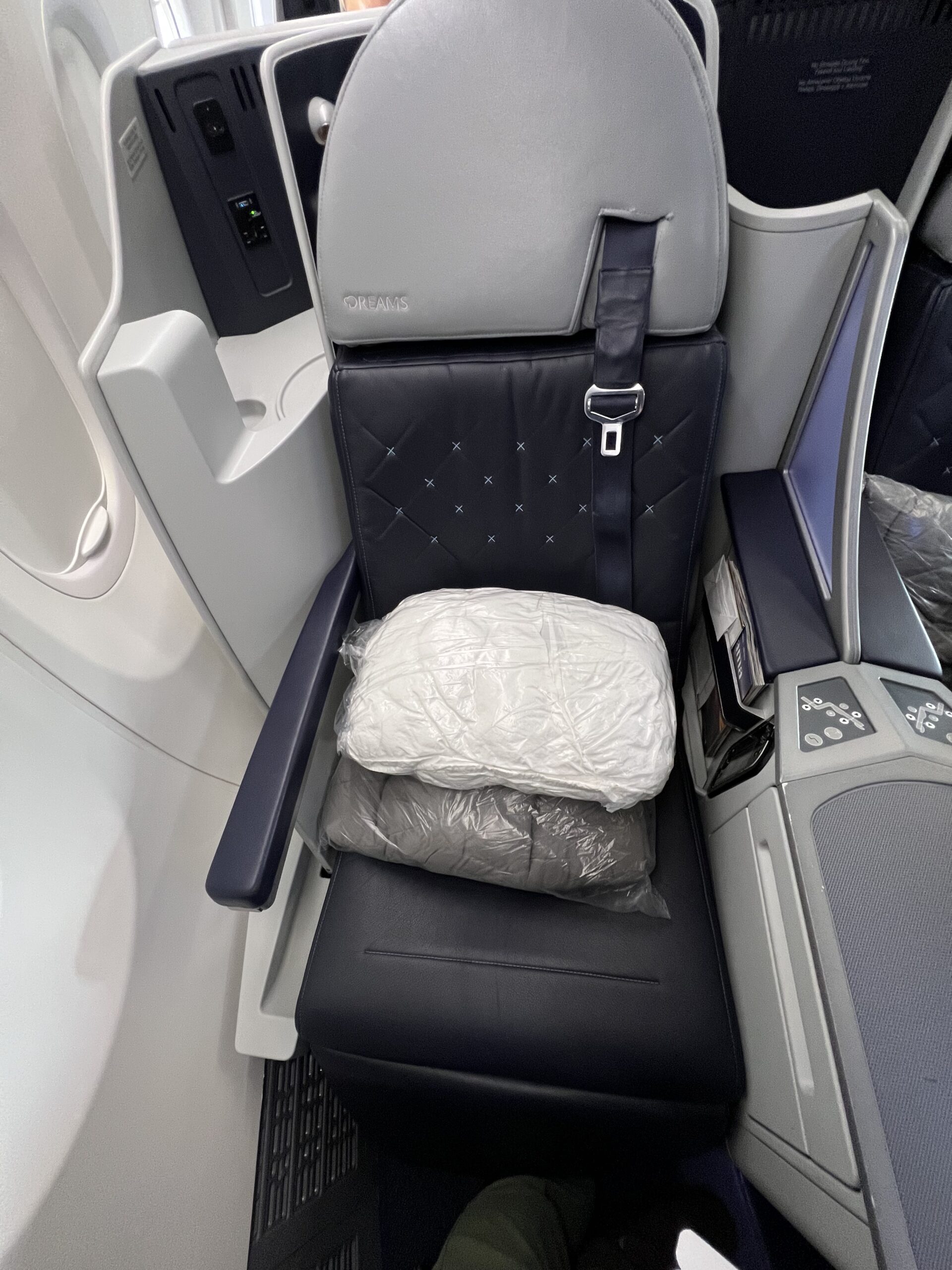Why it’s Perfectly Safe to Fly Boeing 737 MAX 9 Planes Right Now
My seat for the roughly 6.5 hour flight from Panama City to Montevideo, Uruguay in Copa Airlines’ Dreams Business Class, a lie-flat MAX 9 seat that is very comfortable. Photo by: Evan Berman
On January 21st, 2024, I flew Copa Airlines’ Boeing 737 MAX 9 in Business Class from Panama City (PTY) to Montevideo, Uruguay (MVD). The flight was lovely– service was solid, and the food was quite good. Additionally, the seat was quite comfortable for our roughly 6.5 hour flight. None of that is terribly remarkable; however, as I have had many pleasant experiences on various airlines all over the world. What is noteworthy is that I flew the 737 MAX 9– and would do so again!
You may have heard that on January 6th, the door of an Alaska Airlines Boeing 737 MAX 9 plane fell off mid-air and caused an emergency landing. Obviously, that is not great and to make matters worse, after an emergency grounding ordered by the FAA, both United and Alaska discovered loose bolts in several planes, causing a further grounding of MAX 9’s across the world. As a reminder, the 737 MAX 9 is a specific subvariant of the Boeing 737 MAX family (which includes MAX 8, MAX 9, and MAX 10 planes), the latest version of the Boeing 737, designed for longer distances than the original 737s. To clarify, the 737 MAX 8 and MAX 10 variants have not shown any of these issues.
Why Was I Excited to Fly This Plane?
My trip was based around a week spent in Brazil. While I flew LATAM Business Class from Brazil back to the US via Lima (these two flights featured different cabins than the Boeing 787-8 I flew from Santiago to Miami in November 2022– a Boeing 787-9 from Sao Paulo to Lima and a Boeing 767-300ER from Lima to Miami, both featuring 1-2-1 seating arrangements), I opted to fly Copa on the way down. As is typical of my itineraries, I decided to give myself “extra days” in Colombia, Panama, and Uruguay, hence the routing through these countries before heading to Brazil.
Copa operates an exclusively Boeing 737 fleet, with the 737-700 and 737-800 planes operating mostly on shorter and less premium flights (for example my 1-hour flight from Medellín, Colombia to Panama was on a 737-800) with a typical 2-2 recliner configuration in Business Class. These seats are remarkably similar to those found on United planes which makes sense considering Continental Airlines (which merged with United) used to own Copa. That’s also why the livery of the plane is so similar to United’s (and Continental). However, the MAX 9 is something special. While the configuration is also 2-2 in Business Class, the seats are angled slightly towards the side and go fully flat. For this daytime flight, that is not 100% necessary, but it was nice to be able to recline and watch a movie and certainly for a red-eye flight, this would be a godsend.

The other choice I was considering was flying Avianca from Bogota to Sao Paulo directly on their Boeing 787-8. While some people would take a wide-body over a narrow-body plane no matter what– especially given that the 1-2-1 configuration means direct aisle access as opposed to having a seatmate on the 2-2 Copa arrangement, I chose Copa for 3 reasons. First, the service on Avianca is supposed to be horrendous– sometimes no meals are catered on 7+ hour flights, FAs are extremely unfriendly, etc.– while the reviews of Copa crews are stellar for a South American carrier, as borne out by my flights.
Secondly, the timing worked much better. I could have:
- flown into Medellín late Friday night, spent the day exploring Colombia’s 2nd largest city, then heading to Panama in the late afternoon, visiting the Canal and tasting great food before continuing onwards to Montevideo, the highly-regarded capital of Uruguay before arriving in Brazil on Monday OR
- flown into Medellín late Friday night before either taking an early morning flight to Bogota (not seeing Medellín, the city formerly known as the “Most Dangerous City in the World”) or having to make a connection using Avianca and still not seeing much of Medellín before flying down to Brazil and arriving after midnight. You can guess which option I chose!
Finally, I was eager to fly Copa’s MAX 9, the first narrow-body aircraft with lie-flat seating that I have ever flown. I am proud to fly Boeing 787 Dreamliner planes as a resident of Charleston, South Carolina (where they are made!) but with the fear mongering about MAX 9 planes, it is nice to clarify a few things about why it is (mostly safe) to fly these planes.
Not all MAX 9 Planes are Created Equally!
First, let me acknowledge that I am not an engineer. I have no background in aviation other than thousands of miles flown each year. That being said, I have reviewed much of the analysis regarding the MAX 8 crashes of Ethiopian Airlines and Indonesian airline Lion Air of a few years ago as well as the recent incident with Alaska Airlines that caused the grounding of MAX 9 planes in North America.
The reason that I am so comfortable flying a MAX 9 is due to the different designs and sub variants of the plane. In recent years, airplanes have begun to be much more customizable. To give one example, consider the A350-900 plane, Airbus’ flagship wide-body airplane and (due to the issues with Boeing in recent years both in safety/design and timing) the backbone of many airlines worldwide. There is the specially configured so-called A350-900ULR that Singapore Airlines flies. This special configuration features just 161 seats in two classes, 94 Premium Economy Seats in a 2-4-2 configuration and 67 Business Class Seats in a 1-2-1 configuration and allows Singapore to operate the longest flight in the world currently from Singapore to New York (both JFK and Newark), clocking in at over 9,500 miles! Compare that with the dense configuration that low-cost airlines such as French Bee which has 411 seats, with a 2-3-2 configuration in Premium Economy and a 3-4-3 configuration in Economy.

MAX Planes in the US and Abroad:
Airlines in the US, despite complaints about economy being “cattle class” and airlines adding in extra seats at the expense of safety, fly MAX 9 planes with the non-densified configuration. United has 179 seats while Alaska has 178 seats. For what it’s worth, American only flies MAX 8 planes while Delta does not currently operate any MAX planes. The seat count normally would not be notable except for one factor: Boeing offers customization of an additional exit door in economy. Both United and Alaska opted not to include the plug door and they were not required to do so based on the FAA’s regulations on safety (the ratio of passengers to exit doors).
Check out the below photos of the plane I flew from Panama City to Montevideo. Notice the red circle around the exit door in the second picture. That is the emergency door, which is being used on this densified configuration:


Contrast that with the following picture of an Alaska Airlines MAX 9 plane which uses a plug door instead:

Unfortunately, we now know this is what caused the door to detach mid-flight. To be clear, Boeing is almost completely at fault here– the airlines should have done more maintenance and there are rumors that errors were showing on flights before this incident occurred, but Boeing has essentially failed to ensure that their planes were safe for use. We know through a safety report that Spirit, the manufacturer that Boeing for MAX 9 planes has had numerous defects in their planes, though it appears the final blame may lay with Boeing, not Spirit.
On the Alaska flight, the plug door became detached and fell off due to not being bolted to the plane properly. Upon further inspection, there were several loose bolts found that produce more safety hazards. In short, the standard, less-dense configuration MAX 9 planes were grounded for a while until Boeing, the FAA, and the airlines came to an agreement on how to remedy this design error.
Other airlines, namely flydubai and Copa operate MAX 9’s with densified configurations. Since there are many more passengers, the door is required to be installed. To reiterate, on the Alaska flight, the issue was that the plug door was not fully attached and able to fall off. When the door is installed as another exit door, there are no design concerns. Understanding the complexity of the plug door is essential to understanding whether or not you should fly on a MAX 9. In short, I would encourage you to ignore sensational headlines and comments such as never trust a Boeing plane and all MAX 9 planes are a one-way ticket to your death. This is one scenario where you should be grateful for extra seats on the plane– even if you are in Economy!
Copa’s 737 MAX 9 is a Great Option for Business Class flights to South America!

I will have a full review of my Copa Business Class experience but know that it both flights were enjoyable. The seats were comfortable (the 737-8v3 for shorter flights especially, while the MAX 9 is a pleasure for any distance), the service was in line with the best of North and Latin American and European carriers (of course, there is no comparison with Middle Eastern or Asian carriers, though that is an article for another day!), and the food was solid.

Pro tip: if you have a trip to Southern South America, consider flying to South America, then booking an Air Canada Aeroplan award connecting in Panama so you are charged just 35,000 points for intra-South America (as shown above, what I booked) compared to the 50,000 points required for a North or Central American to South America award (Panama is considered Central America for Aeroplan)! That result is shown below:

What do you think? Would you consider flying a MAX 9? Does this article convince you that some of the planes are safe to fly? Let me know what you think!


